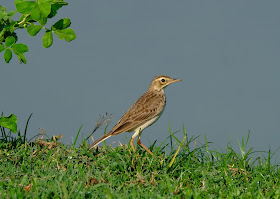One of my elusive bird that I have yet to shoot in the wild is this Purple Throated Sunbird. The opportunity came at Cyberjaya in the month of March 2017
Welcome to my Malaysian Birding Blog. My blog showcases my legacy of sightings of Malaysian bird in my lifetime - the countdown to 688 species and beyond. Actual numbers of birds you can see in Malaysia is more than 850 and adding.
Thursday, 9 March 2017
Wednesday, 8 March 2017
SHRIKE 3/3 - Long-tailed Shrike
Long-tailed Shrike
This is the one of the three Shrike species you can see in Malaysia. It is recorded as a resident in my beloved country ...... actually very rare to see it my side of the KL/Selangor usually in northern state of the Peninsula. It do breed in Malay Peninsula. Easier to see in Thailand. In my case I saw it in Jogyakarta as a caged bird. A beautiful shrike with its long tail probably the Longicaudatus.
It is about 27- 28cm in length. China has the largest population race amongst the nine subspecies . Sexes similar or nearly so. Head and mantle are dark gray, back and rump are rufous; tail is long, black, and graduated; wings are dark with conspicuous white primary patches. Underparts are whitish, strongly tinged with rufous on the sides of breast and flanks. Erythronotus, widespread in central Asia and in the Indian subcontinent, is similar, but distinctly smaller, somewhat duller, and with a narrower black band on the forehead. Caniceps from southern India and Sri Lanka is paler, with less rufous on its upperparts. Race tricolor is a superb Himalayan bird; it bears a black cap, shows a small grayish area on upper mantle, and has mainly deep rufous upperparts. It is rather similar to the three insular races. Race longicaudatus from Thailand has a very long tail. Remarkably, in certain areas, nominate has a melanistic form called fuscatus; mixed pairs have been recorded. Peninsula is called the l.s. Bentet........
A scrub jungle bird, but also associated with lightly wooded country, cultivated areas, and gardens. Generally a bird of lowlands, but in the Himalayas, tricolor populations have been found up to 9,800 ft (3,000 m) and occasionally up to 14,000 ft (4,300 m). Nominate breeds up to 9,800 ft (3,000 m) in China.
Monday, 6 March 2017
Avian Sighting - Crimson Sunbird
Some say there were 3 males seen at the same area of this Lakeside Garden in Cyberjaya. Besides that there are other species like the Purple-throated, Brown-throated and Olive-backed. The latter did show up but the aggressive Crimson chase it away.
Wednesday, 1 March 2017
PIPIT 3/5 - Blyth's Pipit
Lifer 471 - Can you believe it, this is the second record that this visiting bird is been photographed in Peninsula. The first time was in Chuping Perlis by yours truly Dave B.That was in the year 2010. On that occasion it was a day affair and the bird was not to be seen in the vast sugarcane plantation after that. It most probably was there but its like a needle in the haystack to find it.
Coming forward to 2017 surprise! it came this far south.... this is the first time it is been photographed in Perak central peninsula . The good thing is that it stayed for a good part of January until now. Though it is very cautious and vigilant of the humankind and other predators around, it has carved out a niche at Malim Nawar birding site.
Usually the MO to shoot this bird is from your car. Anytime you embark and walk openly to shoot, it will fly to safety like wagtails usually do. So a good beanbag or pillow over your side window screen helps.
Now if you see a pipit feeding as shown in the pictures below chances is that its a Blyth's. This bird tends to jump to pluck seeds to eat in this case the mimosa. The other Paddyfield's Pipit prefers to take grubs and dropped grass seeds from the ground. The bird was seen to be quite aggressive. It would chased away the other pipits but not the grey wagtail which it allowed it into its territory. Paddyfield's usually are seen in a pair whilst the Blyth's keep to itself during visiting Malaysia.
Avian ID - Identifying a Blyth's Pipit
Photo 1 : The streaking on the head is way too weak and faint & ear coverts too dark...........failed
Picture 3 is another Paddyfield Pipit the lore is dark and streaking on breast too distinct .........failed
Picture 4 &5 are the Real McCoy Can you notice the differences.....






















